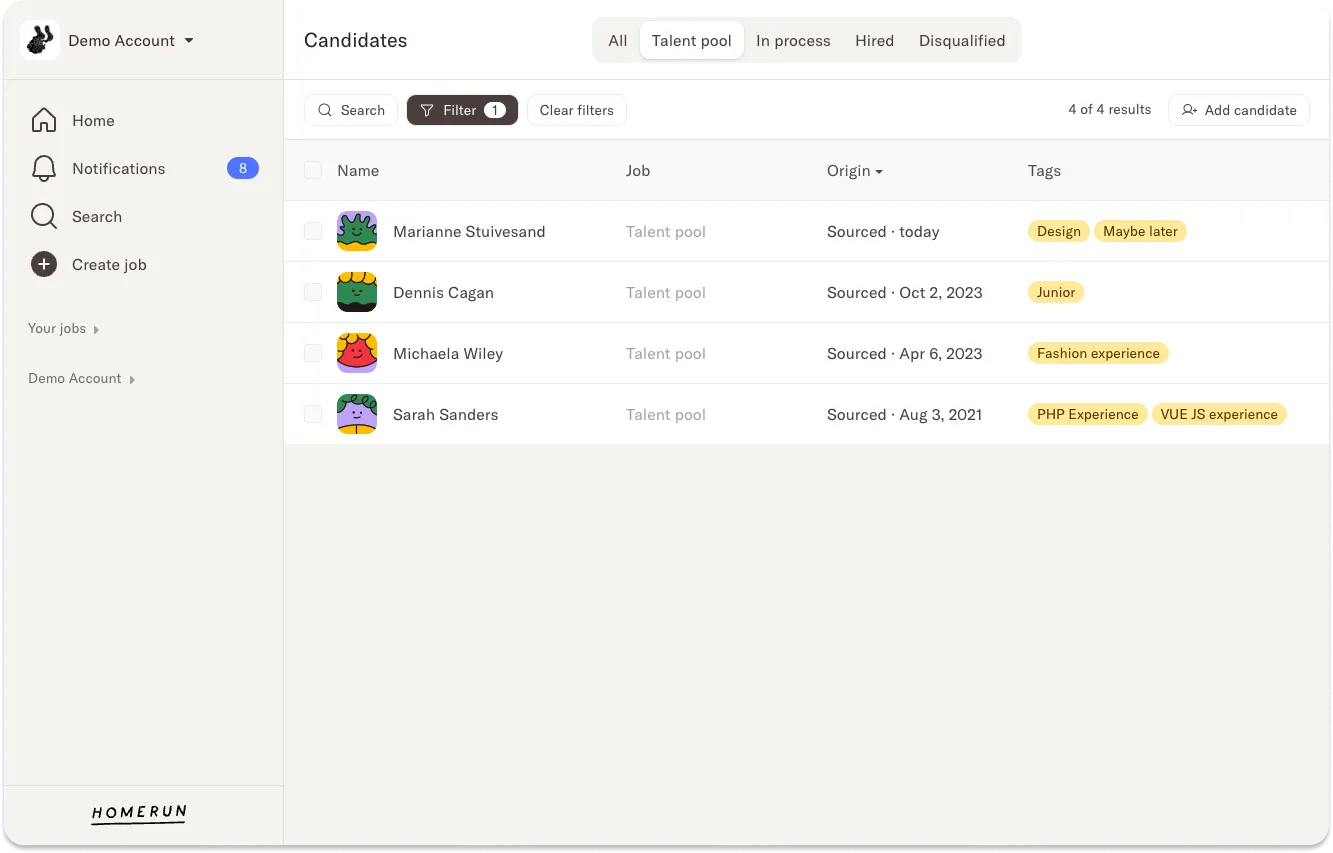
Hiring can be a bit of a rollercoaster — one minute, you're swamped with applications, and the next, you're struggling to find the right fit for your team. That's where talent pools come in.
Your reserve of existing talent can be a total game-changer for your recruitment process, making your candidate hunt smoother and more strategic. Ever heard of the expression work smarter not harder? That's what talent pools do for your hiring.
In this article, we'll dive into (pun very much intended) what talent pools are and how you can build your own to keep your recruitment process running like a well-oiled machine. Ready? I sure am. Let’s get started!
<div id="what-is">What is a talent pool?</div>
A talent pool is a dedicated place where hiring teams organize candidates and potential hires for future roles. Typically created and managed by hiring managers or in-house recruiters, the talent pool is part of an applicant tracking system (ATS) — it helps hiring teams build up a talent bank for future opportunities at the company. A rich and complete talent pool helps teams hire more efficiently and strategically. 🧠
What candidates can you add to a talent pool?
A talent pool can include external candidates and internal candidates (think teammates who have changed roles at the company). Typically a talent pool of candidates can come from just about anywhere!
These sources can include:
- Second-choice applicants from previous hiring processes
- Potential candidates from social media, career fairs, etc.
- Employee referrals or recommendations
- Qualified former employees
How to build a talent pool (6 steps) 💪
Like anything in the hiring process, building a successful talent pool takes some work and dedication to the candidate's experience. Here are our top steps for how to build a talent pool that works both for your business and for applicants applying to your roles:
1. Identify what you’re looking for
Start by clearly defining the skills, experience, and qualities you need in a candidate. Write a job description that honestly reflects these requirements. Transparency is key; the clearer you are, the better prepared you’ll be in your search and the more likely you’ll be to hire the right person for the job at the end of the day.
This step also involves understanding the roles you’ll likely need to fill in the future. By anticipating your company’s growth and changes, you can proactively look for the right talent to fit those needs.
2. Source candidates and make it consistent
Use the talent acquisition channels at your disposal to find potential candidates. This can include job boards, LinkedIn, networking and industry events, previous interview processes and employee referrals. Consistency is crucial here — when you regularly source candidates, your talent pool stays fresh and diverse. 💥
Remember that hiring is a team sport — make your hiring process truly collaborative by encouraging your team to refer qualified candidates. If you need to give them a bit of a push, consider offering incentives (like a referral bonus or a gift!). A varied sourcing approach will bring you a richer, more dynamic talent pool.
3. Organize and tag candidates in your ATS
This one shouldn’t come as a surprise! An efficient applicant tracking system (ATS) is probably the most important tool to build and manage your talent pool.
- Organize your candidates into categories based on skills, experience and potential roles. Tagging candidates with relevant and memorable keywords—such as “Junior,” “PHP experience” or “Management”—makes it easier to search and find them later. This structure helps you quickly match candidates to your roles on your team as they open up.
- If you’ve talked to a former candidate for a second time, update their candidate profile with any new information or skills they’ve acquired since you first added them to your talent pool.

When you have a place to neatly and safely store candidate information, like an ATS, you’re able to use this collection of candidates as a talent pool. That way you can more easily source pre-qualified candidates that might not have been right for a previous role, but are much better suited to a role you’ll hire for in the future.
Use and build your talent pool as a recruitment tool and look at it as another key channel for your talent acquisition. ✨
4. Engage your talent pool
Engagement is key to keeping your talent pool vibrant and interested in your company. Regularly update your talent pool with new candidates and keep in touch with potential hires. Share company updates, industry news, or relevant content to keep them engaged.
Personalized emails or newsletters can also help maintain a connection with high-quality candidates. Highlight your company’s achievements, culture and upcoming opportunities to keep your talent pool engaged and excited about the prospect of working with you.
5. Evaluate and update
A talent pool isn’t something you set and forget; you’ll need to periodically review it to ensure it’s still relevant and up to date. Remove candidates who are no longer a fit and add new ones as needed. This evaluation process should include checking in with candidates to update their availability and interest in potential roles.
A dynamic and efficient talent pool should evolve with your company’s needs and the job market. Regularly assessing your candidates helps you ensure you have a strong selection of talent to choose from — interview scorecards will be a big help for you here!
📣 Candidate evaluations: Assess candidates and hire with confidence
6. Make the candidate experience exceptional
First impressions always matter, especially in recruitment. With that, you want to make sure candidates get a strong, positive experience with your company from the jump. I’m talking clear communication, timely responses and a transparent recruitment process.
Even if a candidate isn’t the right fit for a particular open role, their positive experience will make them more likely to consider future opportunities with you and refer others to your company. Provide constructive feedback when possible and keep the door open for future interactions.
A great candidate experience leaves a lasting impression and builds a positive reputation for your company in the talent market. Even if you don’t want to hire a particular person right now don’t burn bridges!
Why teams need talent pools for consistent, effective recruitment
Whether you needed to hire someone yesterday 😬 or plan on growing your team in the next few months, talent pools are pretty essential for any business with recruitment needs.
Having a pool of qualified talent on-hand means you can hire quickly and more effectively. This reserve of candidates will give you a strategic advantage against competitors since you’ll be more ready to extend a job offer when a position on your team opens up.
Here are some other key benefits to having a candidate pool — no matter how big your team may be:
- 🏃 Faster hiring process: With a talent pool, you already have a list of potential candidates for a specific role. You’ve likely already gone through the application process with them — you may have also interviewed them a few times. With pre-vetted candidates, you reduce the time you spend sourcing new and interviewing applicants.
- 🏠 Centralized candidate information: With all your past candidate information stored in one place, it’s easier to access, assess, review and remind yourself of a candidate’s strengths. This helps teams limit various talent acquisition channels, keeping things simple and easy.
- 🌟 Better candidate quality: By continuously adding candidates to your talent pool, you’ll have access to high-quality candidates who are a good fit for your company and a particular job. Your talent pool candidates are already those you’ve received an application from, interviewed, assessed and vetted. This means you’ll have access to a ready-made list of candidates you see potential in. Win for your hiring team, and a win for the candidate.
- 👍 Improved candidate experience: Engaging with candidates even before a position is open (proactive recruitment) shows that you value their skills and are interested in long-term relationships. Reaching out to candidates (who you may have rejected in the past) also shows them you’re true to your word and serious about your belief in their potential at your business.
- 💰 Cost savings: A well-maintained talent pool can reduce the need for expensive social media ads, job boards, third-party recruitment agencies, employee referral programs, assessment software or background checks. Just log back into your ATS to see who might be the right fit for the role you’re looking to fill.
Make your hiring more efficient with a growing talent pool
Building a talent pool not only makes your recruitment process faster and more efficient but it also helps you build lasting relationships with top-notch candidates. By following these steps, you can more easily create a talent pool that keeps your hiring pipeline full and your team ready to grow.
Remember, a great talent pool is dynamic and ever-evolving, just like your business. Regularly update and engage with your candidates, keep your ATS organized, and always aim to offer your applicants an exceptional candidate experience. This way, you'll always have a pool of qualified, enthusiastic candidates ready to jump in when you need them. ✨














.png)

